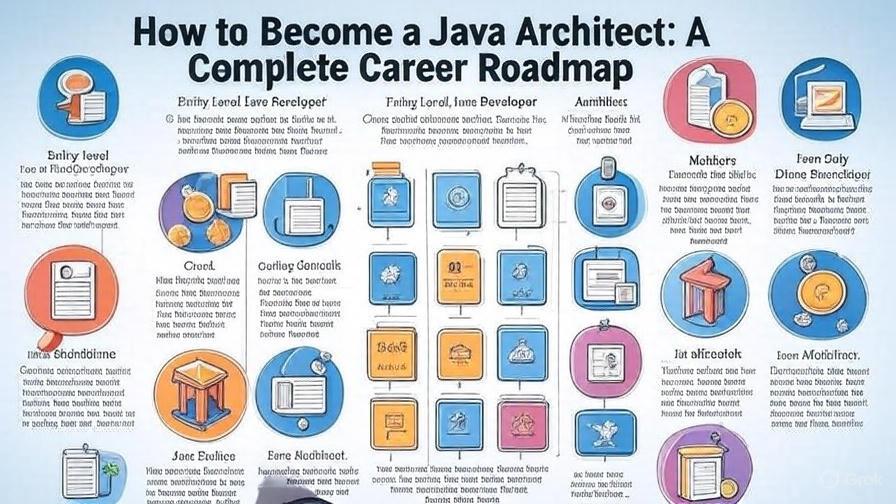How to Become a Java Architect: A Complete Career Roadmap

How to Become a Java Architect: A Complete Career Roadmap
Becoming a Java Architect is a rewarding journey that requires a blend of technical expertise, hands-on experience, and strategic thinking. If you're passionate about Java and aspire to reach the pinnacle of your career as a Java Architect, this guide will provide you with a comprehensive roadmap to achieve your goal.
Embarking on the path to becoming a Java Architect involves more than just mastering the Java programming language. It requires a deep understanding of software architecture, design patterns, and best practices in software development. Whether you're starting as a beginner or looking to advance from a full stack Java developer roadmap, this roadmap will help you navigate the steps necessary to achieve your career aspirations.
Understanding the Role of a Java Architect
A Java Architect is responsible for designing and overseeing the implementation of Java-based applications. They play a crucial role in ensuring that the software meets business requirements, is scalable, and maintains high performance. Key responsibilities include:
-
Designing and implementing software solutions
-
Overseeing the development process
-
Ensuring code quality and performance
-
Collaborating with stakeholders to gather requirements
-
Mentoring and guiding development teams
Educational Background and Prerequisites
Obtaining a Relevant Degree
A strong educational foundation is essential for becoming a Java Architect. Most professionals in this field hold a bachelor's degree in computer science, software engineering, or a related field. Some may also pursue advanced degrees to deepen their knowledge and expertise.
Building a Strong Foundation in Java
Before you can become a Java Architect, you need to have a solid understanding of the Java programming language. This includes knowledge of Java syntax, data structures, algorithms, and object-oriented programming principles. Consider enrolling in courses or obtaining certifications to validate your skills.
Gaining Practical Experience
Starting as a Java Developer
Begin your career as a Java Developer to gain hands-on experience in coding, debugging, and maintaining Java applications. This role will provide you with a solid foundation in Java development and help you understand the software development lifecycle.
Advancing to a Senior Java Developer
As you gain experience, aim to advance to a Senior Java Developer role. In this position, you'll take on more complex tasks, mentor junior developers, and contribute to architectural decisions. This experience is crucial for developing the skills needed to become a Java Architect.
Transitioning to a Java Architect Role
With several years of experience as a Senior Java Developer, you can start transitioning to a Java Architect role. This involves taking on more responsibilities related to software architecture, design, and decision-making. Pursuing a Java Architect certification can also enhance your credentials and demonstrate your expertise.
Developing Key Skills
Mastering Java Frameworks and Technologies
To become a successful Java Architect, you need to master various Java frameworks and technologies. This includes:
-
Spring Framework: Widely used for building enterprise-level applications.
-
Hibernate: An ORM (Object-Relational Mapping) framework for database interactions.
-
Java EE: Enterprise edition of Java for building large-scale applications.
-
Microservices: Architectural style for building scalable and maintainable applications.
Understanding Software Architecture and Design Patterns
A deep understanding of software architecture and design patterns is essential for a Java Architect. Familiarize yourself with:
-
Design Patterns: Such as Singleton, Factory, Observer, and MVC.
-
Architectural Styles: Such as Monolithic, Microservices, and Serverless.
-
Best Practices: For designing scalable, maintainable, and high-performance applications.
Learning DevOps and Cloud Technologies
In today's fast-paced development environment, knowledge of DevOps and cloud technologies is crucial. This includes:
-
CI/CD Pipelines: For continuous integration and continuous deployment.
-
Containerization: Using tools like Docker and Kubernetes.
-
Cloud Platforms: Such as AWS, Azure, and Google Cloud.
Building a Professional Network
Joining Professional Organizations
Joining professional organizations and communities can provide valuable networking opportunities. Consider becoming a member of groups such as the Java User Group (JUG) or the Association for Computing Machinery (ACM).
Attending Conferences and Workshops
Attending industry conferences and workshops is a great way to stay updated on the latest trends and technologies. It also provides opportunities to network with other professionals and learn from industry experts.
Participating in Online Communities
Engage with online communities and forums dedicated to Java development and software architecture. Platforms like Stack Overflow, Reddit, and LinkedIn groups can be valuable resources for learning and networking.
Creating a Portfolio and Showcasing Your Work
Building a Portfolio
Create a portfolio that showcases your projects, contributions, and achievements. This can include:
-
GitHub Repositories: Showcasing your code and contributions to open-source projects.
-
Blog Posts: Writing about your experiences, insights, and best practices.
-
Case Studies: Detailing your involvement in successful projects.
Updating Your Resume and LinkedIn Profile
Ensure your resume and LinkedIn profile are up-to-date and highlight your skills, experience, and achievements. Use keywords related to Java architecture to make your profile more discoverable to recruiters.
Pursuing Continuous Learning and Improvement
Staying Updated with Industry Trends
The field of software development is constantly evolving. Stay updated with the latest trends, technologies, and best practices by reading industry blogs, attending webinars, and following thought leaders on social media.
Pursuing Advanced Certifications
Consider pursuing advanced certifications to enhance your skills and credentials. Certifications such as Oracle Certified Master, Java EE 6 Enterprise Architect, and AWS Certified Solutions Architect can demonstrate your expertise and commitment to continuous learning.
Seeking Mentorship and Guidance
Seek mentorship from experienced Java Architects who can provide guidance, share insights, and help you navigate your career path. Mentorship can be invaluable in gaining practical knowledge and avoiding common pitfalls.
Overcoming Challenges and Staying Motivated
Dealing with Imposter Syndrome
It's common to experience self-doubt and imposter syndrome, especially when transitioning to a new role. Remember that everyone starts somewhere, and it's okay to make mistakes. Focus on your strengths and continue learning and improving.
Balancing Work and Personal Life
Maintaining a healthy work-life balance is crucial for long-term success and well-being. Set boundaries, prioritize self-care, and make time for hobbies and activities that bring you joy.
Staying Motivated and Persistent
The journey to becoming a Java Architect can be challenging and requires persistence and dedication. Stay motivated by setting clear goals, celebrating your achievements, and reminding yourself of the reasons why you chose this career path.
Conclusion
Becoming a Java Architect is a rewarding and fulfilling career path that requires a combination of technical expertise, hands-on experience, and strategic thinking. By following this comprehensive roadmap, you can navigate the steps necessary to achieve your goal and become a successful Java Architect. Remember to stay curious, continue learning, and never stop striving for excellence.
Frequently Asked Questions
What is the role of a Java Architect?
A Java Architect is responsible for designing and overseeing the implementation of Java-based applications, ensuring they meet business requirements and maintain high performance.
What educational background is needed to become a Java Architect?
Most Java Architects hold a bachelor's degree in computer science, software engineering, or a related field. Advanced degrees can also be beneficial.
What are the key responsibilities of a Java Architect?
Key responsibilities include designing software solutions, overseeing the development process, ensuring code quality, collaborating with stakeholders, and mentoring development teams.
How can I gain practical experience as a Java Architect?
Start as a Java Developer, advance to a Senior Java Developer role, and then transition to a Java Architect position by taking on architectural responsibilities.
What skills are essential for a Java Architect?
Essential skills include mastery of Java frameworks, understanding of software architecture and design patterns, and knowledge of DevOps and cloud technologies.
How important is networking for a Java Architect?
Networking is crucial for staying updated on industry trends, learning from peers, and discovering new opportunities. Join professional organizations, attend conferences, and participate in online communities.
What should I include in my portfolio as a Java Architect?
Your portfolio should include GitHub repositories, blog posts, case studies, and any other projects or contributions that showcase your skills and experience.
How can I stay updated with industry trends?
Stay updated by reading industry blogs, attending webinars, following thought leaders on social media, and pursuing advanced certifications.
What are some common challenges faced by Java Architects?
Common challenges include dealing with imposter syndrome, balancing work and personal life, and staying motivated and persistent in the face of obstacles.
How can mentorship help in becoming a Java Architect?
Mentorship can provide guidance, share insights, and help you navigate your career path. Seek mentorship from experienced Java Architects to gain practical knowledge and avoid common pitfalls.







